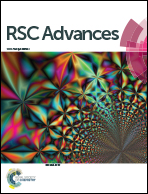Ionic strength-modulated catalytic efficiency of a multienzyme cascade nanoconfined on charged hierarchical scaffolds†
Abstract
Understanding the effect of ionic strength on the efficiency of this enzyme cascade within charged hierarchical nanospace is not only fundamentally interesting, but also important for translating biochemical pathways to noncellular environments. We herein report ionic strength-modulated efficiency for the enzyme cascade (glucose oxidase (GOx) and horseradish peroxidase (HRP)) within the dendritic polyethylene-cationic poly(p-phenylene ethynylene) (DPE-PPE+) biocompatible scaffold. The largest enhancement in activity is observed for DPE-PPE+/GOx/HRP system with adding simple salt sodium chloride (0.9 M), which is almost 3 times higher than the corresponding control without the addition of salt. A decrease in the transient time is experimentally observed in DPE-PPE+/GOx/HRP system with increasing salt concentration from 0 M to 0.9 M, being in good agreement with the salt-regulated efficiency results. The cationic conjugated PPE+ shell of DPE-PPE+ is employed as a probe to monitor the ionic strength-modulated electrostatic shielding effects, which has influence on the enzyme release and enzymatic activity for the DPE-PPE+/GOx/HRP.


 Please wait while we load your content...
Please wait while we load your content...